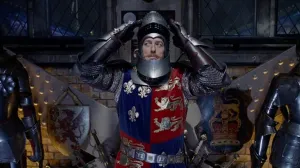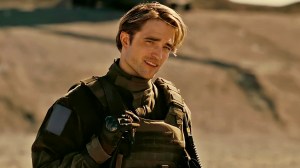
Dark Knight Returns: The Golden Child continues the relatively new tradition of DC Comics and Frank Miller tacking another ending onto a saga that never demanded to be more than its original story. While all of these projects from The Dark Knight Strikes Again forward are generally unnecessary, they tend to bring out the best in Miller and attract artists and approaches that are engaging if nothing else.
Videos by ComicBook.com
This new chapter tells the story of Batman, Superman, and Wonder Woman’s various heirs. The old men appear briefly or only referenced, leaving the Earth and plot entirely to those who come next. Carrie Kelly (now in the role of Batman), Lara (sporting both the S and Ws worn by her parents), and Jonathan (still a superpowered little boy) face off against some familiar villains in the midst of many clear allusions to the current political state of the United States. Donald Trump appears prominently on television screens and elsewhere, now portrayed as the puppet of Darkseid and Joker.
A very early appearance by the president, his unmistakable caricature chidingly hidden behind the name Governor, suggests that The Golden Child is prepared to take on the politics of our day, but nothing could be further from the truth. Trump and his villainous co-conspirators provide the vague sort of evil on which recent Justice League comics have thrived. They never present an ideology or act in any recognizably human manner. The protestors who align with them in the street where Joker makeup rather than MAGA hats; only a general condemnation of Trump is offered by Carrie who describes him as “an asshole.” While The Golden Child is prepared to use Trump’s image, it fails to critique the man or his administration in any meaningful manner.
There may be an element of apology to this portrayal. Creator Frank Miller’s recent work has been plagued with strains of Islamophobia, sexism, and various other strains of degeneracy that have caused plenty of controversy around the current White House. This comic fails to rebut any of those critiques leveled at Miller, pointing at Trump instead as if to say, “Hey, I’m definitely not with that jerk.” Even that doesn’t sound honest set side-by-side with so many overtly sexualized images of the story’s young heroines though.

None of this is intended to suggest that The Golden Child is a bad comic, merely a toothless one that likely doesn’t merit a tenth of the vitriol it may generate. While it speaks with a hollow voice, it delivers that material in a spectacular fashion. The simple plotting of a trio of heroes facing a trio of villains lends itself to an easily understood conflict that can generate plenty of colorful action and chaos.
For the uninitiated this issue will serve as a delightful introduction to the work of Rafael Grampá, arguably the greatest artist in action comics today. Even in a crowded street brawl, his approach demands careful attention to every figure and detail revealing a city filled with animated expressions and bodies dramatically contorted in combat. The Golden Child doesn’t deliver the gore or absurd perspective choices that elevate prior works like Mesmo Delivery Service, but there’s not a single page which can be skimmed. Even the most standard storytelling sequences offer intricate facial responses and a keen eye for geographic details.
This level of consideration being applied to the standard plot tropes of DC superhero comics may remind some readers that these comics can be genuinely exciting, especially given the exceedingly low bar set by the majority of mainstream capes fare. Batwoman’s street level battles deliver the gusto of a body blow to readers and induce cringes with a few nasty tricks. The high-powered antics of Lara, Jonathan, and Darkseid thrill to the heights of shonen manga, re-upping the stakes page after page with some spectacular color work from Jordie Bellaire enhancing the universal struggle.
Grampá exceeds expectations by playing with the artistic tradition fostered throughout more than 30 years of these Dark Knight comics. His style is modulated to evoke the work of Miller, Eduardo Risso, and other artistic alumni from the various sequels. His line work is (and has been) far more precise than Miller’s increasingly frenetic and scratchy portrayals in the original Dark Knight Returns, but he sometimes bunches those carefully considered lines and adds enough ink to return readers to that rush of unexpected energy and violence that first appeared in 1986. There’s a clear appreciation for Risso (and his similarly excellent work on The Last Crusade), especially in a high contrast sequence that highlights black and white faces with dazzling focal points of color.
This is the reason to read Dark Knight Returns: The Golden Child, as a simple story stylishly told. None of the angry politics that infused its originator are present and all the use it has for an even angrier present is to borrow its aesthetic. That unwillingness to engage can be frustrating at a few points, but generally assists in keeping Miller’s script out of the way of the absurd action it calls for on the page. This is The Dark Knight Returns updated for a new generation by conversion to a rollercoaster ride. It may not have much to say, but Grampá’s approach ought to have you more concerned with who’s getting punched and how hard.
Published by DC Comics
On December 11, 2019
Written by Frank Miller
Art by Rafael Grampá
Colors by Jordie Bellaire
Letters by John Workman and Deron Bennett
Cover by Rafael Grampá and Pedro Cobiaco








